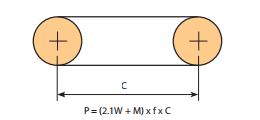Introduction
A mindful assessment of your ailments surrounding a conveyor is necessary for correct conveyor chain assortment. This part discusses the essential concerns needed for productive conveyor chain variety. Roller Chains are often utilised for light to moderate duty materials managing applications. Environmental circumstances may perhaps call for using special materials, platings coatings, lubricants or even the capability to operate without having added external lubrication.
Simple Facts Required For Chain Selection
? Type of chain conveyor (unit or bulk) which includes the approach of conveyance (attachments, buckets, by way of rods etc).
? Conveyor layout which include sprocket places, inclines (if any) along with the number of chain strands (N) to become applied.
? Amount of materials (M in lbs/ft or kN/m) and style of material to be conveyed.
? Estimated weight of conveyor components (W in lbs/ft or kN/m) such as chain, slats or attachments (if any).
? Linear chain velocity (S in ft/min or m/min).
? Environment through which the chain will operate together with temperature, corrosion circumstance, lubrication issue etc.
Phase 1: Estimate Chain Tension
Use the formula below to estimate the conveyor Pull (Pest) after which the chain tension (Check). Pest = (M + W) x f x SF and
Test = Pest / N
f = Coefficient of Friction
SF = Speed Factor
Stage 2: Make a Tentative Chain Choice
Employing the Test value, make a tentative assortment by selecting a chain
whose rated functioning load better than the calculated Check value.These values are ideal for conveyor service and therefore are diff erent from these shown in tables at the front in the catalog which are linked to slow speed drive chain utilization.
On top of that to suffi cient load carrying capability normally these chains must be of a selected pitch to accommodate a sought after attachment spacing. Such as if slats are to be bolted to an attachment every one.five inches, the pitch from the chain picked must divide into one.5?¡À. Consequently 1 could use a forty chain (1/2?¡À pitch) with all the attachments each and every 3rd, a 60 chain (3/4?¡À pitch) with all the attachments each 2nd, a 120 chain (1-1/2?¡À pitch) with the attachments each pitch or maybe a C2060H chain (1-1/2?¡À pitch) with the attachments every pitch.
Stage three: Finalize Variety – Calculate Real Conveyor Pull
Following making a tentative variety we need to verify it by calculating
the real chain tension (T). To accomplish this we ought to fi rst determine  the actual conveyor pull (P). From your layouts shown on the appropriate side of this page pick out the proper formula and calculate the complete conveyor pull. Note that some conveyors might be a combination of horizontal, inclined and vertical . . . in that situation calculate the conveyor Pull at each and every segment and include them collectively.
the actual conveyor pull (P). From your layouts shown on the appropriate side of this page pick out the proper formula and calculate the complete conveyor pull. Note that some conveyors might be a combination of horizontal, inclined and vertical . . . in that situation calculate the conveyor Pull at each and every segment and include them collectively.
Step four: Calculate Greatest Chain Stress
The maximum Chain Tension (T) equals the Conveyor Pull (P) as calculated in Stage 3 divided through the number of strands carrying the load (N), occasions the Pace Component (SF) proven in Table two, the Multi-Strand Component (MSF) shown in Table 3 and the Temperature Issue (TF) proven in Table four.
T = (P / N) x MSF x SF x TF
Phase five: Verify the ?¡ãRated Operating Load?¡À on the Selected Chain
The ?¡ãRated Operating Load?¡À in the picked chain really should be better compared to the Maximum Chain Tension (T) calculated in Stage 4 over. These values are acceptable for conveyor service and therefore are diff erent from people shown in tables with the front on the catalog that are associated with slow pace drive chain utilization.
Step 6: Test the ?¡ãAllowable Roller Load?¡À from the Picked Chain
For chains that roll around the chain rollers or on prime roller attachments it is needed to test the Allowable Roller Load?¡À.
Note: the Roller load is established by:
Roller Load = Wr / Nr
Wr = The total fat carried by the rollers
Nr = The quantity of rollers supporting the weight.
